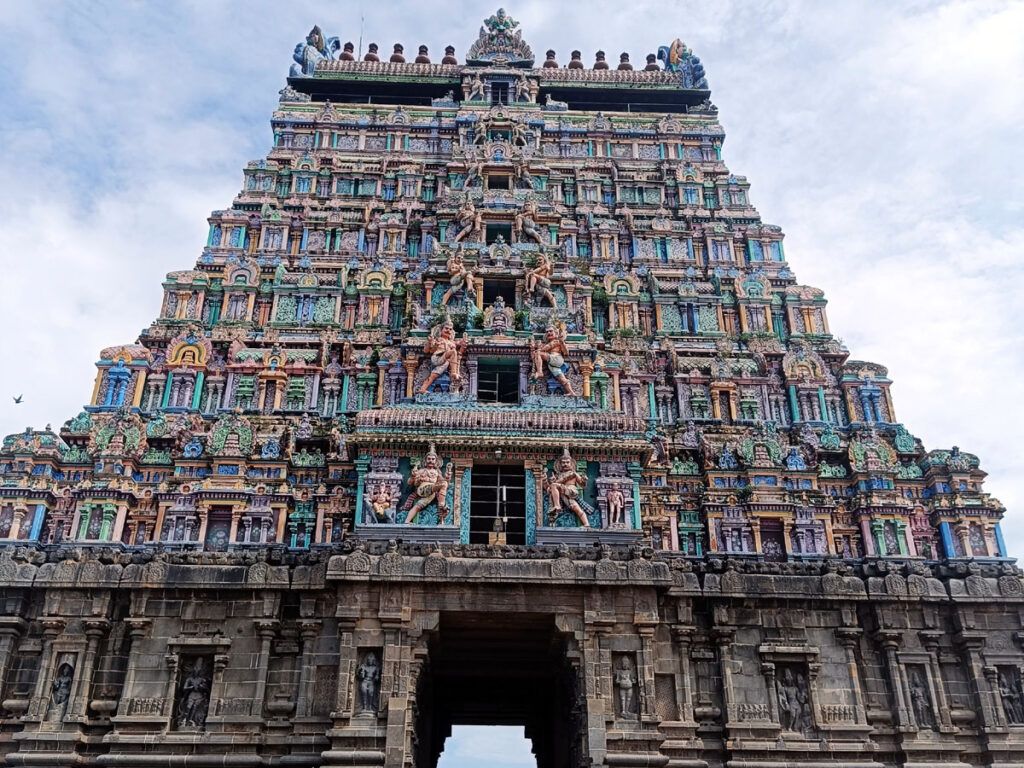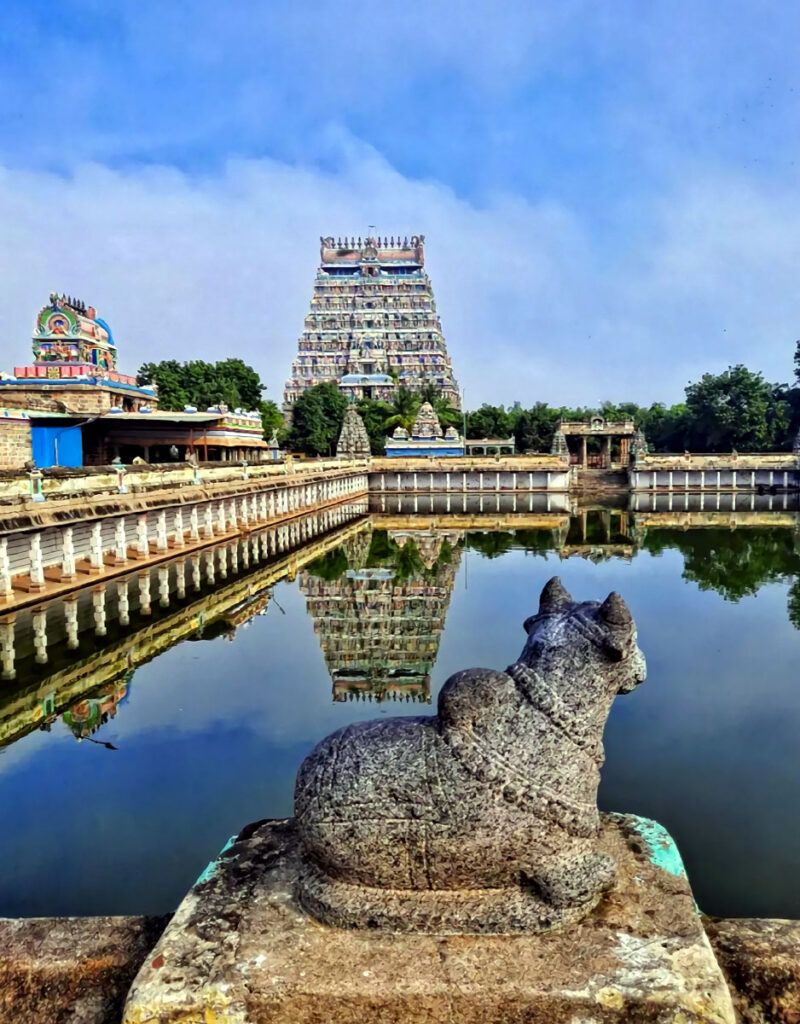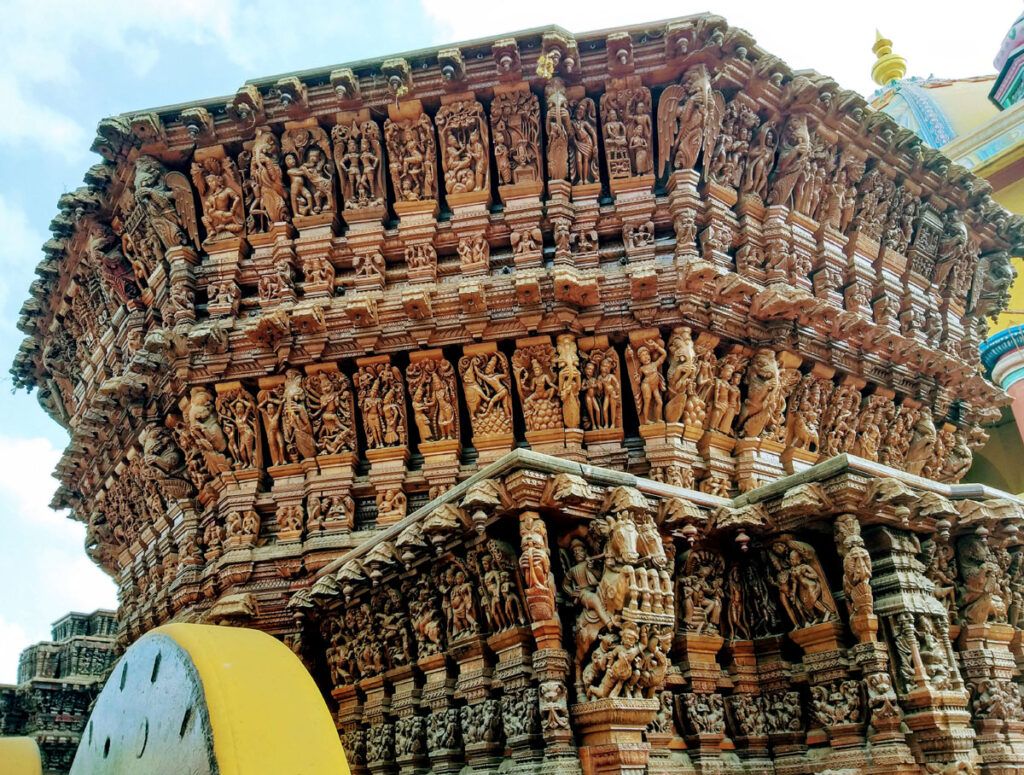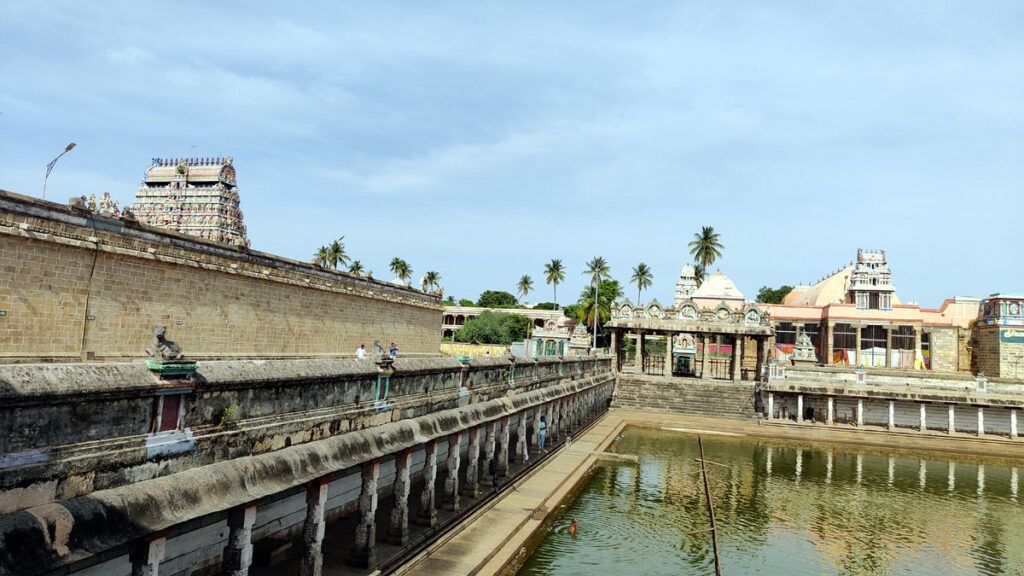Enchanting Chidambaram Nataraja Temple: 5 Formless Akasha Lingam
Chidambaram Nataraja Temple is a historic Hindu temple dedicated to the Nataraja form of Lord Shiva, revered as the Lord of Dance. Located in the town of Chidambaram, Tamil Nadu, India, the temple is one of the most revered Shiva temples in South India and is considered one of the five ancient Pancha Bhuta Sthalam, representing the element of ether (Akasha).

Contents
- 1 History of Chidambaram Nataraja Temple:
- 2 Legend of Chidambaram Nataraja Temple:
- 3 Cosmic Dance of Chidambaram Nataraja Temple:
- 4 Myths and Beliefs of Chidambaram Nataraja Temple:
- 5 Significance of Chidambaram Nataraja Temple:
- 6 Festival and Celebration at Chidambaram Nataraja Temple:
- 7 Chidambaram Nataraja Temple Timing:
- 8 Architecture of Chidambaram Nataraja Temple:
- 9 Chidambaram Temple Scientific Facts:
- 10 Places to visit near Chidambaram Nataraja Temple:
- 11 FAQ:
- 11.0.1 1. What is the Chidambaram Nataraja Temple?
- 11.0.2 2. When was the Chidambaram Nataraja Temple built?
- 11.0.3 3. What is the significance of the Chidambaram Nataraja Temple?
- 11.0.4 4. What is the Nataraja statue?
- 11.0.5 5. What are the five sabhas of the Chidambaram Nataraja Temple?
- 11.0.6 6. What are the festivals celebrated at the Chidambaram Nataraja Temple?
- 11.0.7 7. How can I reach the Chidambaram Nataraja Temple?
- 11.0.8 8. What are the timings of the Chidambaram Nataraja Temple?
- 11.0.9 9. What is the dress code for visiting the Chidambaram Nataraja Temple?
- 11.0.10 10. Can I take photos inside the Chidambaram Nataraja Temple?
- 12 How to reach Chidambaram Nataraja Temple:
- 13 Google Maps:
History of Chidambaram Nataraja Temple:
Ancient Origins:
The origins of the Chidambaram Nataraja Temple are ancient and shrouded in mythology. It is believed to have existed for several centuries, with mentions in various ancient texts. The temple is associated with Lord Shiva and his cosmic dance, which is depicted in the form of Nataraja, the Lord of Dance.
Chola Dynasty:
The temple gained prominence during the Chola dynasty (9th to 13th centuries), particularly during the reign of Rajaraja Chola I and Rajendra Chola I. They are credited with significant contributions to the temple’s architecture and development. The temple complex as it stands today reflects the architectural grandeur of the Chola period.
Renovations and Patronage:
Over the centuries, the temple underwent various renovations and modifications. Different rulers and dynasties, including the Vijayanagara Empire and the Nayak rulers, contributed to the maintenance and enhancement of the temple.

Legend of Chidambaram Nataraja Temple:
The legend of the Chidambaram Nataraja Temple is a fascinating tale that is deeply intertwined with the history and spirituality of the temple. The story begins with Lord Shiva and Goddess Parvati, who were engaged in a playful argument about who was more powerful. To settle the dispute, they decided to have a dance competition. Shiva performed his cosmic dance, the Ananda Tandava, which represents the creation, preservation, and destruction of the universe. Parvati, unable to match Shiva’s divine dance, conceded defeat.
Impressed by Shiva’s performance, the gods and sages requested him to establish a permanent abode where he could continue to dance for the benefit of all beings. Shiva agreed and chose Chidambaram as the location for his cosmic dance. The temple was built around the sacred spot where Shiva is said to have danced.
The Chidambaram Nataraja Temple is a magnificent architectural masterpiece, with towering gopurams (gateways) and intricate sculptures adorning its walls. The temple’s sanctum sanctorum houses the iconic Nataraja bronze statue, which is considered one of the finest examples of Chola bronzes. The statue depicts Shiva in his cosmic dance pose, with four arms representing the four cardinal directions and his right foot crushing the demon Apasmara, symbolizing the ego.
Cosmic Dance of Chidambaram Nataraja Temple:
The cosmic dance of Lord Shiva, known as the Ananda Tandava, is a symbolic representation of the creation, preservation, and destruction of the universe. It is said that Shiva performs this dance in the Chidambaram Nataraja Temple in Tamil Nadu, India.
The dance is depicted with Shiva standing on one leg, with his other leg raised in a gesture of triumph. His four arms represent the four cardinal directions, and his hands hold the drum of creation, the fire of destruction, the axe of dissolution, and the lily of knowledge.
The dance is said to be a continuous cycle of creation, preservation, and destruction. Shiva’s dance is not just a physical movement; it is also a spiritual dance that represents the cosmic rhythm of the universe.

Myths and Beliefs of Chidambaram Nataraja Temple:
There are many myths and beliefs associated with the Chidambaram Nataraja Temple. One of the most famous myths is the story of how Shiva came to dance at Chidambaram. According to the legend, Shiva was once challenged to a dance competition by the demon Tripurasura. Shiva agreed to the competition and danced with such skill and grace that Tripurasura was defeated. To celebrate his victory, Shiva decided to dance for all eternity. He chose Chidambaram as the location for his cosmic dance because it is the center of the universe.
Another famous myth is the story of how the golden roof of the Chidambaram Nataraja Temple was built. According to the legend, the roof was built by the celestial beings known as the Devas. The Devas were so impressed with Shiva’s dance that they decided to build him a temple with a roof made of gold.
The Chidambaram Nataraja Temple is also home to a number of sacred objects, including the Panchamurti bronze statue, which depicts Shiva in his five forms. The temple is also home to the Akasha Lingam, a pillar of light that is said to be the form of Shiva.
The Chidambaram Nataraja Temple is a place of great spiritual significance for Hindus. The temple is believed to be a place where one can attain moksha, liberation from the cycle of birth and death.

Significance of Chidambaram Nataraja Temple:
- Spiritual and Religious Significance: The Chidambaram Nataraja Temple is one of the most sacred sites in Hinduism, considered one of the five Panchabootha Sthalams, representing the five elements of nature. The temple is a major pilgrimage destination for Hindus from all over the world, who come to seek blessings and spiritual enlightenment.
- Artistic and Cultural Significance: The temple is renowned for its magnificent architecture and exquisite sculptures, showcasing the finest achievements of Chola art and architecture. The Nataraja sculpture, the temple’s centerpiece, is considered a masterpiece of Chola bronze artistry, exemplifying the perfect balance of form, movement, and symbolism.
- Symbolism of Nataraja: The Nataraja sculpture encapsulates the profound symbolism of Shiva as the cosmic dancer, embodying the eternal cycle of creation, preservation, and destruction. The dance represents the divine play of God, the rhythm of the universe, and the unity of all existence.
- Historical Significance: The temple has a rich and storied history, dating back to the 6th century CE. It has been patronized by numerous dynasties, including the Pallavas, Cholas, and Nayaks, each contributing to its architectural and artistic splendor.
Festival and Celebration at Chidambaram Nataraja Temple:
Aani Thirumanjanam: This is a 10-day festival that is celebrated in June-July. The main event of the festival is the procession of Lord Nataraja’s chariot around the four main streets of Chidambaram. Thousands of devotees gather to witness this spectacular event.
Arudra Darshan: This is another 10-day festival that is celebrated in December-January. The main event of the festival is the worship of Lord Nataraja in his cosmic dance form. Devotees believe that worshipping Lord Nataraja in this form can help them to attain moksha (liberation from the cycle of birth and death).
Marghazhi Thiruvaadhirai: This is a one-day festival that is celebrated in December-January. The festival marks the beginning of the Tamil month of Marghazi. Lord Nataraja is decorated with special ornaments and abhishekam (sacred bath) is performed.
Natyanjali Dance Festival: This is a seven-day festival that is celebrated in February-March. The festival is dedicated to Lord Shiva as Nataraja, the divine dancer. During the festival, there are performances of Bharatanatyam, a classical Indian dance form, by dancers from all over India.

Chidambaram Nataraja Temple Timing:
Chidambaram Nataraja Temple is open from 6:00 AM to 12:30 PM and from 4:30 PM to 10:00 PM. It is closed on Fridays for special abhishekam (holy bath) to the deity.
Here is a list of the pooja timings:
- Maha Aarthi: 7:45 AM to 9:00 AM
- Kalasandhi Pooja: 6:00 AM to 6:30 AM
- Irandaam Kaalam: 9:00 AM to 9:30 AM
- Uchikalaam: 12:00 PM to 12:30 PM
- Saayarakshai: 4:30 PM to 5:00 PM
- Irandaam Kaalam: 5:00 PM to 5:30 PM
- Ardhajaamam: 9:00 PM to 10:00 PM
Architecture of Chidambaram Nataraja Temple:
- Sanctum Sanctorum (Garbhagriha): The main shrine of the temple houses the deity Lord Nataraja in the Ananda Tandava (the dance of bliss) pose. The sanctum is a small, dark chamber symbolizing the cosmic void or the heart, and only the priests are allowed inside.
- Raja Sabha (Hall of 1000 Pillars): This hall is characterized by its numerous granite pillars, each carved with intricate details. The hall is also known as the “Nritya Sabha” or the “Dance Hall,” and it is believed that 108 dance poses are depicted in the form of small bronze images in the temple.
- Chit Sabha (Hall of Consciousness): This hall is associated with wisdom and learning. It is believed that Lord Shiva danced his cosmic dance of bliss here. The roof of this hall is gold-plated.
- Kanaka Sabha (Gold Sabha): This hall is dedicated to Lord Nataraja and is adorned with gold-plated tiles. It is considered very sacred, and the rituals performed here are believed to confer great merit.
- Nritta Sabha: This is another hall associated with dance performances and festivities. It is situated to the south of the Chit Sabha.
- Sculptures and Carvings: The temple is renowned for its intricate sculptures and carvings that depict various mythological stories, deities, and divine themes.
- Gopurams (Gateway Towers): The temple complex has several gopurams, with the eastern gopuram being the tallest and most ornate. These towers are elaborately carved and are adorned with various sculptures and figures.
- Tank (Ponniyamman Kovil Tank): The temple complex includes a large tank called Sivaganga, which is considered sacred. Pilgrims often take a ritual bath in this tank before entering the temple.
Chidambaram Temple Scientific Facts:
- Alignment with the Earth’s Magnetic Equator:
The Chidambaram Temple lies remarkably close to the Earth’s magnetic equator, the imaginary line where the Earth’s magnetic field is perpendicular to the surface. This alignment is considered significant in various spiritual traditions, believed to foster a heightened state of consciousness and promote spiritual growth.
- Cosmic Resonance and Sonic Proportions:
The temple’s architecture and dimensions exhibit a harmonious relationship with cosmic cycles and sonic principles. The dimensions of the sanctum sanctorum, known as the Nataraja Shrine, resonate with the Earth’s rotation and orbital period. Additionally, the placement of pillars and temple halls creates sound chambers that produce natural reverberations, believed to induce meditative states.
- Symbolic Representation of Human Physiology:
The temple’s design subtly mirrors the human body’s intricate anatomy. The nine gateways of the temple complex represent the nine primary orifices of the human body, while the 21,600 gold sheets adorning the temple’s roof are said to correspond to the number of breaths taken by an average human in a day.
- Acoustics and Energy Harmonization:
The temple’s construction incorporates acoustic principles that enhance sound propagation and amplify the rhythmic chantings and devotional music performed within its premises. The temple’s layout, with its various halls and courtyards, is believed to create a unique energy field that promotes a sense of tranquility and well-being.
- Astronomical and Astrological Alignments:
The temple’s orientation and various architectural features align with celestial bodies and astrological principles. The temple’s axis is aligned with the north star, Polaris, while the placement of certain shrines and structures corresponds to zodiac constellations and cosmic cycles.
- Symbology of Cosmic Elements:
The Chidambaram Temple is considered one of the five elemental temples, representing the five primary elements of nature: earth, water, fire, air, and ether. The Nataraja Shrine, housing the sacred Akasha Linga, symbolizes the ether element, representing the essence of consciousness and the all-pervading cosmic energy.
Places to visit near Chidambaram Nataraja Temple:
- Pichavaram Mangrove Forest:
- Located about 16 kilometers from Chidambaram, Pichavaram is famous for its mangrove forests and backwaters. You can take boat rides through the mangrove channels and enjoy the serene natural beauty.
- Gangaikonda Cholapuram:
- Approximately 60 kilometers from Chidambaram, this UNESCO World Heritage Site was built by Rajendra Chola I and is known for its architectural grandeur. The Brihadeeswarar Temple in Gangaikonda Cholapuram is a must-visit.
- Kumbakonam:
- About 66 kilometers away, Kumbakonam is renowned for its temples and is often referred to as the “Temple Town.” Navagraha Temples, Mahamaham Tank, and Sarangapani Temple are some of the notable attractions.
- Darasuram Airavatesvara Temple:
- A UNESCO World Heritage Site, this temple is dedicated to Lord Shiva and is known for its intricate carvings and architecture. It is around 78 kilometers from Chidambaram.
- Thillai Kali Amman Temple:
- Located in Chidambaram itself, this temple dedicated to Goddess Kali is a significant pilgrimage site and is known for its vibrant festivals.
- Vaitheeswaran Koil:
- Around 25 kilometers from Chidambaram, this temple is dedicated to Lord Shiva as Vaitheeswaran, the divine physician. It is believed to have healing powers, and the temple is associated with the Navagrahas.
- Kailasanathar Temple, Thirukollikadu:
- Situated about 13 kilometers away, this temple is dedicated to Lord Shiva and is known for its ancient inscriptions and unique architecture.
- Neyveli Lignite Corporation (NLC) Township:
- If you’re interested in industrial tours, Neyveli, about 36 kilometers from Chidambaram, is home to the Neyveli Lignite Corporation. You can visit the lignite mines and power plants.
FAQ:
1. What is the Chidambaram Nataraja Temple?
The Chidambaram Nataraja Temple is a Hindu temple dedicated to Lord Shiva, located in the town of Chidambaram in Tamil Nadu, India. It is one of the most revered temples in South India and is known for its iconic bronze statue of Nataraja, the cosmic dancer of Hinduism.
2. When was the Chidambaram Nataraja Temple built?
The temple is believed to have been built in the 10th century AD by the Chola dynasty. However, there is archaeological evidence to suggest that the site has been a place of worship for much longer.
3. What is the significance of the Chidambaram Nataraja Temple?
The Chidambaram Nataraja Temple is considered to be one of the five holiest Shiva temples in India. It is also one of the 18 Shakti Peethas, sacred sites associated with the Hindu goddess Shakti.
4. What is the Nataraja statue?
The Nataraja statue is a bronze sculpture that depicts Lord Shiva as the cosmic dancer. The statue is considered to be a masterpiece of Hindu art and is one of the most recognizable icons of Hinduism.
5. What are the five sabhas of the Chidambaram Nataraja Temple?
The Chidambaram Nataraja Temple has five sabhas, or halls, each of which is dedicated to a different aspect of Lord Shiva. The five sabhas are:
- Chit Sabha: The main hall, where the Nataraja statue is housed
- Kanakasabha: The hall of gold
- Raja Sabha: The hall of kings
- Devasabha: The hall of gods
- Nritta Sabha: The hall of dance
6. What are the festivals celebrated at the Chidambaram Nataraja Temple?
The Chidambaram Nataraja Temple is a major pilgrimage center and hosts a number of festivals throughout the year. The most important festivals are:
- Nataraja Abhishekam: A festival celebrated in honor of Lord Nataraja, during which the Nataraja statue is bathed in milk, water, and other sacred substances.
- Arudra Darshan: A festival celebrated in honor of Lord Shiva, during which the Lord Shiva statue is decorated with special ornaments.
- Brahmotsavam: A ten-day festival that is the most important festival of the Chidambaram Nataraja Temple.
7. How can I reach the Chidambaram Nataraja Temple?
The Chidambaram Nataraja Temple is located in the town of Chidambaram, which is well-connected by road and rail. The nearest airport is in Trichy, which is about 90 kilometers away.
8. What are the timings of the Chidambaram Nataraja Temple?
The Chidambaram Nataraja Temple is open from 6:00 AM to 10:00 PM daily. The temple is closed for two hours in the afternoon, from 1:00 PM to 3:00 PM.
9. What is the dress code for visiting the Chidambaram Nataraja Temple?
Men are required to wear traditional Indian attire, such as a dhoti and kurta. Women are required to wear sarees or salwar kameezes. Shorts and sleeveless tops are not allowed.
10. Can I take photos inside the Chidambaram Nataraja Temple?
Photography is not allowed inside the sanctum sanctorum of the temple. However, photography is allowed in other parts of the temple complex.
How to reach Chidambaram Nataraja Temple:
By Air:
The nearest airport to Chidambaram is in Trichy (Tiruchirapalli), which is approximately 195 kilometers away. From the airport, you can hire a taxi or use other modes of transportation to reach Chidambaram.
By Train:
Chidambaram has its own railway station called Chidambaram Junction. It is well-connected to major cities in Tamil Nadu and other parts of the country. Once you reach the Chidambaram Junction, you can hire a local transport or walk to the temple, as it is located in the heart of the town.
By Bus:
Chidambaram is well-connected by road, and there are regular bus services from nearby cities and towns. You can take a bus to the Chidambaram Bus Stand, which is close to the temple.
By Car:
If you are traveling by car, Chidambaram is easily accessible by road. The town is well-connected by National Highways and State Highways. You can use GPS or follow road signs to reach Chidambaram. The temple is located in the central part of the town, and there are parking facilities available.
Local Transportation:
Once you reach Chidambaram, you can use local transportation options like auto-rickshaws or cycle rickshaws to reach the Nataraja Temple. The temple is a prominent landmark in the town, and locals can guide you to its location.

4 Comments